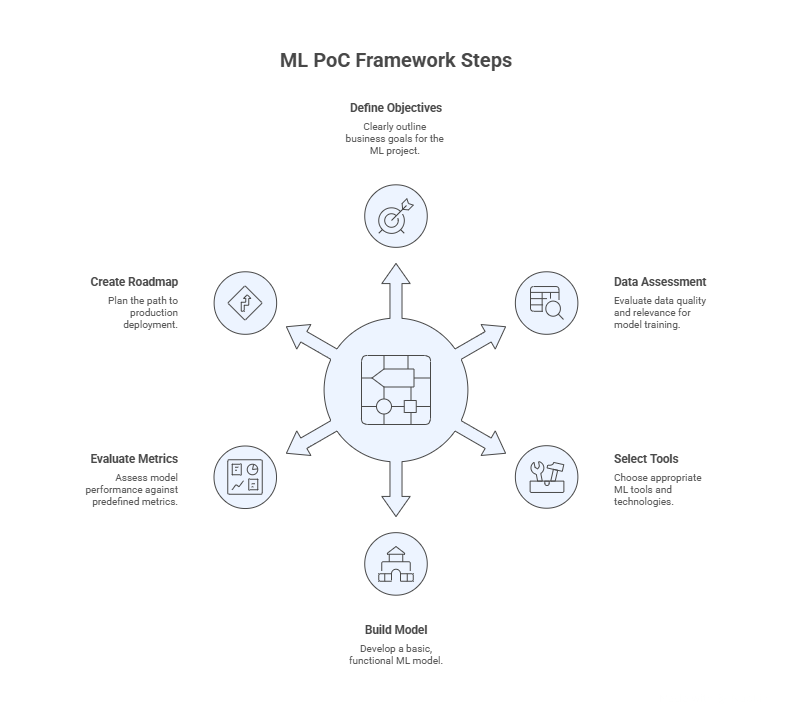Machine Learning PoC Explained: How ML Proof-of-Concept Projects Are Planned & Executed
Introduction
Before investing hundreds of thousands in full-scale AI development, smart businesses run Machine Learning Proof-of-Concept projects. An ML PoC validates whether your AI idea solves real problems, works with your data, and delivers measurable ROI, all within 4-8 weeks and controlled budgets.
The challenge? 87% of data science projects never make it to production (VentureBeat, 2024). The primary reason is skipping the PoC phase or executing it poorly.
What Is an ML Proof-of-Concept?
An ML Proof-of-Concept is a small-scale experiment testing whether machine learning can solve a specific business problem with available data. Unlike full deployments, PoCs focus on feasibility, not perfection, proving your concept works before scaling investment.
Why ML PoCs Are Essential
- Risk Reduction: Organizations running structured PoCs reduce AI project failure rates by 60% (Gartner, 2024). You’re testing hypotheses with minimal resource commitment.
- Data Reality Check: 80% of AI project time goes to data preparation (IBM Research, 2023). A PoC uncovers data quality issues, volume gaps, and accessibility problems before they derail production builds.
- Stakeholder Buy-In: Executives need proof, not promises. PoCs deliver concrete metrics that justify larger investments.
The 6-Step ML PoC Framework

1. Define Measurable Business Objectives
- Start with precision. Vague goals fail. Instead, target specific outcomes:
- “Predict customer churn 14 days in advance with 80% accuracy”
- “Reduce invoice processing time from 45 minutes to 5 minutes.”
- “Automate 60% of tier-1 support tickets”
Connect objectives to business metrics, cost savings, revenue impact, or efficiency gains.
2. Conduct Comprehensive Data Assessment
Before choosing algorithms, audit your data:
- Volume: Do you have 1,000+ labeled examples for supervised learning?
- Quality: What percentage has missing values? Are formats consistent?
- Accessibility: Do you have legal permissions and technical access?
- Relevance: Does your data contain the patterns you’re trying to predict?
3. Select the Right ML Tools
Your tool choice depends on problem type and data reality, not hype:
| Data Type | Recommended Tools | Best For |
| Structured/Tabular | Scikit-learn, XGBoost | Predictions, fraud detection |
| Unstructured | TensorFlow, PyTorch | Computer vision, NLP |
| Limited Data | Transfer Learning | Niche use cases |
| Rapid Testing | AutoML platforms | Quick experimentation |
Start simple: A logistic regression achieving 78% accuracy in two weeks beats a neural network requiring six months for 82%.
4. Build a Minimum Viable Model
Focus on proving core functionality:
- Establish a Baseline: Create the simplest solution first. Your ML model must beat this to prove value.
- Test with Real Data: Use actual business data; edge cases reveal crucial insights.
- Iterate Quickly: Build → Test → Learn → Refine. Document what works and what fails during each cycle of AI model training.
5. Evaluate Against Success Metrics
Measure your PoC using metrics from Step 1 and compare performance with current processes. Since only 13% of AI pilots scale, a PoC exposing challenges can save significant costs early.
6. Create a Production Roadmap
Document requirements like computing needs, data pipelines, model operations, version control, retraining schedules, and team skills. Set realistic timelines based on PoC insights instead of assumptions.
Critical Mistakes to Avoid
- Overengineering Early: Start simple, add complexity only when necessary
- Ignoring Production Constraints: Consider latency, memory, and integration needs
- Working in Isolation: Include business stakeholders throughout
- Chasing Perfect Accuracy: An 82% accurate deployed model beats 94% stuck in refinement
- Neglecting Explainability: Stakeholders won’t trust models they can’t understand
Also Read : AI Proof of Concept Guide: Steps, Benefits & Best Practices
When to Partner with ML Development Experts
Successful ML PoCs require a delicate balance between technical execution and business alignment. Choose partners who:
- Ask about your business goals before recommending algorithms
- Have real production ML experience, not just demos
- Use clear and transparent evaluation methods
- Understand the challenges in your specific industry
As a trusted provider of AI development services, Amplework Software turns ML PoCs into practical, ROI-driven outcomes.
Conclusion
A properly executed ML PoC transforms AI curiosity into strategic implementations with quantified ROI. Following this framework helps you avoid the 87% failure rate and build ML solutions that deliver actual business value. Start with clear objectives, honest data assessment, and structured execution to validate your ML idea with confidence.


 sales@amplework.com
sales@amplework.com
 (+91) 9636-962-228
(+91) 9636-962-228





